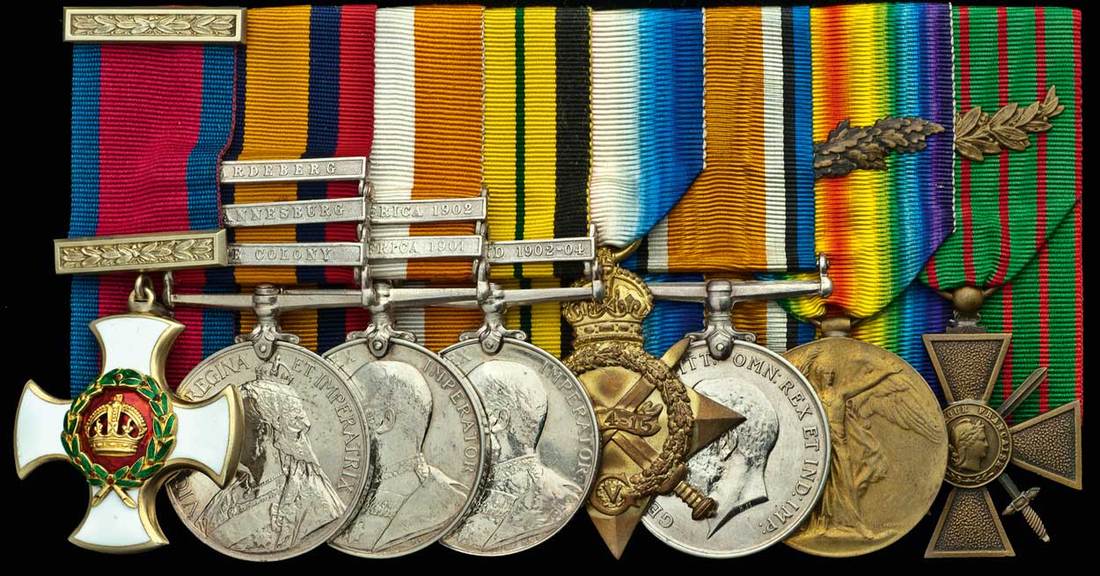
Auction: 323 - The Numismatic Collector's Series Sale
Lot: 759
A Good Great War 1918 'Western Front' D.S.O. Group of Eight to Lieutenant-Colonel Herbert Hemming, South African Forces, Late East Lancashire Regiment, Who Served During the Great War in German South West Africa With the Rand Rifles; in Egypt, Where He Lost an Arm at the Battle of Agagia, February 1916; and on The Western Front, Where He Was Again Wounded at Delville Wood, August 1916, and Gassed at Passchendaele, September 1917. Wounded For a Third Time, He Subsequently Served against the Germans and Bolsheviks in Lithuania, Before Joining the Auxiliary Division, Royal Irish Constabulary in January 1921 and Given the Command of 'G' Company
a) Distinguished Service Order, G.V.R., silver-gilt and enamel, with integral top riband bar, reverse pin removed for mounting purposes
b) Queen's South Africa 1899-1902, three clasps, Cape Colony, Johannesburg, Paardeberg, top lugs removed (Lieut. H.S.L. Hemming. E: Lanc: R.)
c) King's South Africa 1901-02, two clasps (Lt. H.S.L. Hemming. E. Lanc. Rgt.)
d) Africa General Service 1902-56, E.VII.R., one clasp, Somaliland 1902-04 (Lieut. H.S. Lamond Hemming. East Lancas. Regt.), renamed in upright sans-serif capitals
e) 1914-15 Star (Capt. H.S.J.L. Hemming. Rand Rfls.)
f) British War and Victory Medals, bi-lingual reverse, M.I.D. Oakleaves (Lieut. Col. H.S.J.L. Hemming.), rank privately corrected on both
g) France, Third Republic, Croix de Guerre, reverse dated 1914-1918, with bronze palm on riband, light contact marks, good very fine or better, mounted court-style for display purposes (8)
D.S.O. London Gazette 3.6.1918 Maj. Herbert Sidney Lamond Hemming, Inf., South African Contingent
The Recommendation, dated 25.2.1918, states: 'This officer has served with his regiment at the front since January 1916 with the exception of periods of absence on account of wounds. He has been Second in Command of a Battalion and for short periods in command and although suffering much pain from the stump of an arm lost in action, he has borne it with the greatest courage, and after every operation or wound, has returned to duty at the earliest possible moment. He has been three times wounded.'
Lieutenant-Colonel Herbert Sidney Jenner Lamond Hemming, D.S.O., was born in London in June 1882, the son of Dr. John Hemming, and was educated at Bedford Grammar School. Commissioned Second Lieutenant in the East Lancashire Regiment in 1900, he served with the Regiment in the Boer War, and later in Somaliland in 1903. Resigning his Commission in 1906, he spent nine years exploring and great game hunting in the interior of Africa, and served with the Portuguese forces in Machemba and in the Matuka Expedition. On the outbreak of the Great War he joined the South African Forces, and in October 1914 was posted as Adjutant to the Rand Rifles with the rank of Captain. He served in the Boer Rebellion and in German South West Africa Campaign of 1914, and was Mentioned in Despatches (London Gazette 9.7.1915) for 'capable and energetic good work throughout the campaign.' Promoted Major in December 1915, he served with the 3rd South African Infantry Regiment in Egypt from January 1916, and at the Battle of Agagia, 26.2.1916, he was seriously wounded and lost his right arm, being the Regiment's most senior casualty. Re-joining the Brigade in France in August 1916 he was wounded for a second time at Delville Wood, 29.8.1916, during the Battle of the Somme, and returned to England for treatment. Recommended for a second Mention in Despatches, for 'showing exceptional keenness and devotion to duty as Adjutant and as a Company Commander during the last two years in German South West Africa, Egypt, and France. In Egypt he led his company with skill and in a dashing manner, till severely wounded, and since his return to duty in France his constant hard work and fine example has been outstanding', he returned to his Brigade in March 1917 and was present throughout the Ypres offensive, being gassed at Passchendaele, 20.9.1917. Assuming temporary command of the 3rd Regiment with the rank of Lieutenant-Colonel in late September 1917, he was wounded a third time at Gouzancourt, 18.1.1918, receiving a fracture to the left radius; was again Mentioned in Despatches (London Gazette 29.5.1918); and was awarded the Distinguished Service Order and the French Croix de Guerre. Relinquishing his Commission on account of ill-health caused by wounds in November 1919, he was granted the rank of Lieutenant-Colonel, and subsequently served as General Staff Officer on General Crozier's Mission in Lithuania 1919-20, and in operations against the Germans and Bolsheviks in 1920-21. Moving to Ireland, he joined the Auxiliary Division of the Royal Irish Constabulary, a paramilitary organisation within the R.I.C. composed of ex-British officers who had formerly served in the Great War, and was given the Command of 'G' Company, 2.2.1921, subsequently taking part in operations against the rebels, before being given the command of the South East Brigade Ulster Special Constabulary following the creation of the Irish Free State in 1922, a position he held until his retirement in 1926. He died in London in February 1947.
Sold for
$3,500




